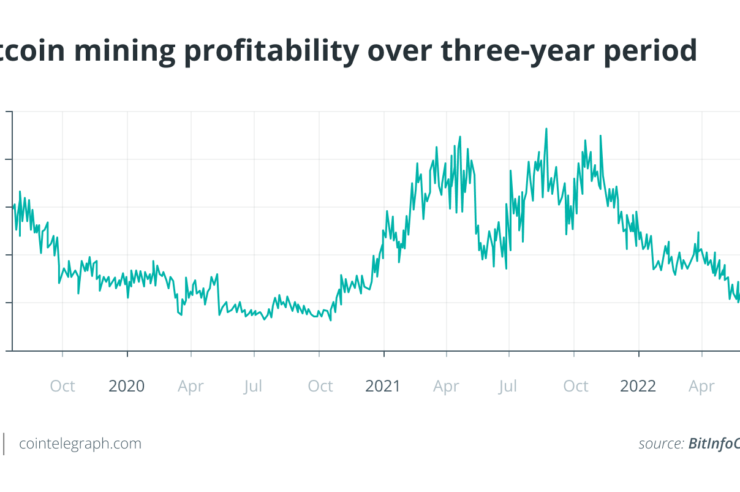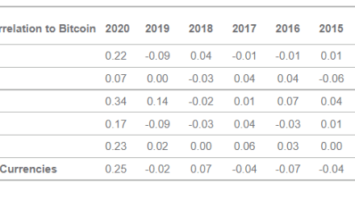The ongoing cryptocurrency bear market has triggered a massive decline in Bitcoin (BTC) mining profitability as BTC mining expenses outpace the price of Bitcoin.
Closely tied to the drop in the BTC price, Bitcoin mining profitability has been tanking since late 2021 and reached its lowest multi-month levels in early July 2022.
According to data from crypto tracking website Bitinfocharts, BTC mining profitability tumbled to as low as $0.07 per day per 1 terahash per second (THash/s) on July 1, 2022, touching the lowest level since October 2020.


The decline in BTC mining profitability has caused some big changes in the crypto mining industry.
Lower Bitcoin prices fueled selling pressure as miners were pushed to sell their BTC to continue mining and pay for electricity. The majority of big crypto mining firms like Core Scientific had to sell a significant amount of Bitcoin in order to survive the tough market conditions.
The growing unprofitability of BTC mining has also triggered a big drop in demand for crypto mining devices, causing many miners to sell their mining hardware at a discount.
As lower prices of application-specific integrated circuit (ASIC) miners and graphics processing units (GPU) may drive more interest from new miners, it’s crucial to remember that the price of mining hardware is just one out of many factors behind BTC mining profitability.
What is Bitcoin mining profitability and how is it defined?
Bitcoin mining is an economic activity that involves the production of the digital currency Bitcoin using the computing power of GPU-based miners or specifically-designed ASIC miners.
Bitcoin mining profitability is a measure defining the degree to which a Bitcoin miner yields profit based on a wide number of factors, including the price of Bitcoin, the mining difficulty, the cost of energy, the type of mining hardware and others.
Factor 1: Bitcoin price and block rewards
The price of Bitcoin is one of the most evident factors impacting the BTC mining profitability as the value of BTC is directly proportional to profits yielded by miners.
Bear markets trigger even more attention to BTC price from miners because they risk losing money if BTC drops below a certain price level.
Miners should also take into account the amount of the block reward or the amount of BTC given to miners for mining one block on the BTC blockchain. Bitcoin’s original block reward amounted to as much as 50 BTC before it was cut to the current 6.5 BTC following three historical block reward halvings.
Bitcoin halvings are a major part of the BTC protocol, aiming to decrease the quantity of the new coins entering the network by cutting the block reward in half every 210,000 blocks or approximately every four years.
Factor 2: Bitcoin mining hardware characteristics
Bitcoin mining profitability largely depends on the choice of a BTC mining device and related characteristics including hash rate, power consumption and price.
Hash rate is the processing power of a miner, measured in hashes per second (H/S). Higher hash rates include representations in kilohashes per second (KH/S), gigahashes per second (GH/S), terahashes per second (TH/S), exahashes per second (EH/S) and so on.
A miner’s hash rate is the speed at which it can solve crypto mining puzzles to mine Bitcoin. The faster the speed, the more BTC is mined in a specific timeframe. As the BTC hash rate is constantly breaking new highs, Bitcoin miner manufacturers regularly produce new mining devices supporting higher hash rates, while older miners apparently become obsolete over time.
Another important feature of a BTC mining device is the energy consumption. With rising global energy costs, a miner’s ability to consume less energy is essential.
The price of actual mining devices is also an important expense when calculating the BTC mining profitability. Both GPU and ASIC miners got cheaper amid the bear market this year, but brand new flagship miners still cost more than $11,000 at the time of writing.
Factor 3: Mining difficulty and hash rate
Bitcoin mining difficulty is a measure of how hard it is to mine a BTC block, with a higher difficulty requiring additional computing power to verify transactions and mine new coins.
Network difficulty has been rising in 2022, continually breaking new all-time highs. Bitcoin’s mining difficulty adjustment occurs every 2,016 blocks, or about every two weeks, as Bitcoin is programmed to self-adjust in order to maintain a target block time of 10 minutes.
The Bitcoin hash rate is another fundamental metric for assessing the strength of the BTC network, as a higher hashrate means more computing power is required to verify and add transactions to the blockchain. This also makes BTC more secure because it would take more miners as well as more energy and time to take over the network.
Factor 4: Electricity costs
The price of electricity is another important factor when calculating the profitability of BTC mining.
Miners consider electricity prices in various countries in compliance with local crypto mining regulations. As mining activity puts extra stress on a power grid, it’s important to double-check local requirements and specific energy prices for powering BTC miners in this or that country or region.
Bitcoin mining can be powered by many energy sources, both renewable like wind and solar and nonrenewable sources including fossil fuels like coal, oil and natural gas. Amid soaring energy prices caused by recent supply issues, miners should pay special attention to possible implications on BTC mining income when using nonrenewable energy.
Factor 5: Pool fee if not mining solo
Many Bitcoin miners prefer to join mining pools instead of working as individual miners. That is a way to combine their computing power and increase the chances of finding a block and mining BTC faster.
Pool miners should be aware of another small expense that is taken by pool admins that set up the software for this type of mining. The fee is generally 1-3% of the miner’s individual reward, depending on the pool.
Factor 6: Other expenses
Bitcoin mining expenses are not exclusive to ASICs and GPUs and network indicators. BTC mining may also require some additional investment related to the physical mining setup, including facilities and property that are a good fit. Significant expenses may include cooling or noise canceling equipment as some miner machines are associated with a massive amount of heat and noise pollution.
Crypto mining calculators
One of the easiest ways to calculate Bitcoin mining profitability based on all the listed factors is using online BTC mining calculators.
Designed to simplify the process of calculating Bitcoin mining profitability, a BTC mining calculator predicts the approximate mining income based on inputs like BTC price, hash rate, electricity price and others.
Let’s take an example of calculating Bitcoin mining profitability with a brand new Bitmain ASIC Antminer S19 Pro using the BTC mining calculator by crypto market data provider CryptoCompare.
Antminer S19 Pro has a maximum hashrate of 110TH/s and power consumption of 3250W. Let’s assume that a miner’s pool fee is 2% and the miner is based in North Dakota, where the average residential electricity rate in 2022 amounts to roughly $0.11, versus the United States national average price of roughly $0.14.
Related: BTC mining costs reach 10-month lows as miners use more efficient rigs
Given these variables, the daily profit ratio accounts for 27%, with possible BTC mining profits amounting to $70 per month, or $840 per year, according to CryptoCompare. In contrast, given the U.S. national average electricity price of $0.14, the daily profit ratio amounts to 0% or even generates a loss with the current BTC price and other network indicators.






















Comments (No)